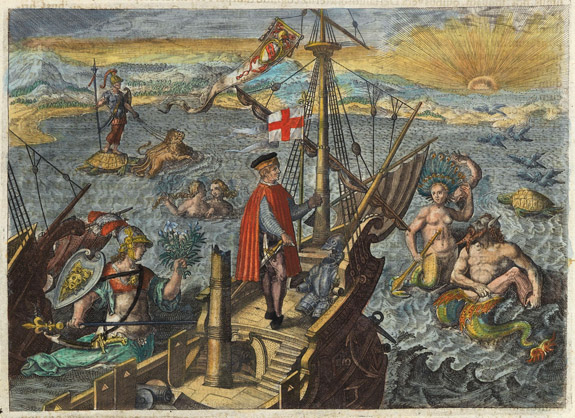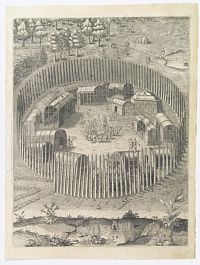"Les Grand Voyages" by Theodore De Bry

Theodore De Bry (1528-1598), was born in Liege in modern-day Belgium. Around 1570, when the Spanish invaded the Low Countries he fled to the German city of Strasbourg, where he set up as a goldsmith and engraver. This experience gave him an anti-Spanish outlook. In 1587, de Bry traveled to London to meet with a Frenchman named Jacques le Moyne. When the first accounts of Dutch, Spanish, and British explorers to Asia, South, and North America began to be published in the 1580s, De Bry became interested in producing illustrated editions of these early travel reports.
Living in London in the 1580s, he met the geographer Richard Hakluyt. But it was only after settling in Frankfurt, already in his 60s, that de Bry published his first books, Les Grands Voyages, or "The Discovery of America” as well as the similar Petits Voyages, or the "India Orientalis” series.
Theodore de Bry began his compilation of early voyages in 1590, and had published six parts at the time of his death in 1598. His widow, two sons, and another family member continued the work, which comprised a total of fifty-four parts when it was completed in 1630. The publication brought to the European public the first realistic visualization of the exotic world opened up across the Atlantic by the explorers, conquerors and settlers” (Alexander).
Les Grand Voyages.
 In the late 1580's he traveled to London, where he made a series of engravings based on the watercolors of John White. De Bry and his family settled in Frankfort, Germany, where in 1590, he produced an illustrated edition of Thomas Hariot's A Briefe and True Report of the New Found Land of Virginia.
In the late 1580's he traveled to London, where he made a series of engravings based on the watercolors of John White. De Bry and his family settled in Frankfort, Germany, where in 1590, he produced an illustrated edition of Thomas Hariot's A Briefe and True Report of the New Found Land of Virginia.
De Bry worked with another engraver, Gijsbert van Veen (1558-1630), whose signature appears on some of the plates. "A Briefe and True Report" would be the first volume of De Bry's ten-volume "America" series, which included illustrated editions of other accounts of exploration in the Americas.
While De Bry's engravings of native North and South Americans were based either on paintings, written descriptions, or both, his images reflect his decidedly European bias. Nonetheless, these were the first images many people saw of North and South America and helped to encourage European interest in the "new world."
De Bry finished the first six parts before his death in 1598, engraving 184 plates and six of the nine eventual maps.
His widow and sons produced Parts VII-IX, containing the voyages of Schmidel, Drake, Hawkins, Cavendish, Raleigh, Acosta, De Weert, and Van Noort.
The remaining four parts were published by De Bry’s sons in 1619-1620 and by his son-in-law Mathew Merian in 1624 and 1634. De Bry published Benzoni’s chronicle in three portions, comprising Parts IV-VI of his Grands Voyages.
A Latin translation first appeared in 1579.
A German edition of the Petit Voyages was published in 1599 in Frankfurt am Main.
A second German edition came out in 1616.
Latin editions were published in 1609 and 1629.
Part I. - [Thomas Hariot's Virginia.] Admiranda narration fida tamen, de commodis et incolarum ritibus Virginiae, …. Anglico scripta sermone a Thoma Hariot . 1590. With the folding map of Virginia and 28 plates after John White
Part II. - [Jacques Le Moyne's Florida.] Brevis narratio eorum quae in Florida Americae provincia Gallis acciderunt … auctore Jacobo Le Moyne . 1591. With a double-page engraved map of Florida.
Part III. - [Hans Stadius's Brazil.] Americae tertia pars memorabilem provinciae Brasiliae historiam continens Germanico primum sermone scriptum a Ioane Stadio . 1592. With a folding map of Peru and Brasil.
Part IV. - [Girolamo Benzoni's History of the New World.] Americae pars quarta sive, insignis & admiranda historia de reperta primum Occidentali India a Christophoro Columbo anno MCCCCXCII scripta ab Hieronymo Benzono. 1594. With a double-page engraved map of the West Indies, engraved text illustration of Columbus led by marine deities, and an engraved text illustration of a world map with medallion portraits of Columbus and Vespucci.
Part V. - [Benzoni's History continued.] Americae pars quinta, nobilis & admiratione plena Hieronymi Bezoni … secunae sectionis Hi[stori]a[e] Hispanorum tum in Nigrittas servos suos, tum in Indias crudelitatem, Gallorumq[ue] pirataru[m] de Hispanis toties reportata spolia. 1595. With an engraved double-page map of New Spain.
Part VI. - [Benzoni's History concluded.] Americae pars sexta, sive historiae ab Hieronymo Be[n]zono … scriptae, sectio tertia. 1596. With a double-page map of the Western Hemisphere with figures of Columbus, Vespucci, Magellan and Pizarro, a double-page engraved view Cusco.
Part VII. - [Ulrich Schmidel's Brazil and Paraguay.] Americae pars VII. Verissima et iucundissima descriptio praecipuarum quarundam Indiae regionum & Insularum . 1599.
Part VIII. - [Voyages of Francis Drake, Thomas Cavendish, and Walter Raleigh.] Americae pars VIII. Continens primo, descriptionem trium itinerum … Francisci Draken … secundo … Thomae Candisch … tertio … Gualtheri Ralegh . 1599. With a vignette map of the world showing Drake's circumnavigation, and a double-page engraved map of Guiana, an engraved map of the world on the verso of leaf KK4 showing Cavendish's circumnavigation, map of the North Atlantic.
Part IX. - [Acosta's History of the New World and others.] Americae nona & postrema pars. Qua de ratione elementorum: de novi orbis natura … copiose petractatur. 1602. Map of Magellan Straits.
Part X. - [Amerigo Vespucci's Voyages, Ralph Hamor's Virginia, and John Smith's Description of New England.] Americae pars decima: qua continentur, I. duae navigationes D[omi]n[i] Americi Vesputii … II. Solida narratio de moderno provinciae Virginiae … authore Raphe Hamor … III. Vera descriptio Novae Angliae … a Capitaneo Johanne Schmidt. 1619.
Part XI. - [The circumnavigations of Willem Schouten and Joris van Spilbergen.] Americae pars undecima: Seu description admirandi intineris a Guillielmo Schouten … peracti . 1619. With 3 engraved maps (1 small format folding map of New Guinea, one folding map of the South Pacific, and 1 of the straits of Magellan), map of 'Mar di India'.
Part XII. - [Antonio de Herrera's West Indies, More's Voyage of the Nodals to the Straits of Magellan, etc.] Novi orbis pars duodecima. Sive descriptio Indiae occidentalis, auctore Antonio de Herrera . 1624. With a double-page map of the western hemisphere,
Les Petit Voyages.
This work comprises probably the greatest single collection of material on early voyages to the East Indies and is unique in its extraordinary wealth of cartographical and visual material on Africa, India, the Spice Islands, and South Asia.
Read more about his "Les Petit Voyages" here.
Johann Theodore de Bry.
Johann Theodore de Bry (1561-1623) was born in Liège in 1561, the eldest son of the engraver and publisher Theodore de Bry. It was from his father that Johann learned his craft, producing both engravings and etchings. In 1588, the Lutheran De Bry family settled in Frankfurt am Main, a safe haven for Lutherans at this time of religious discord. Together with his father and brother (Johann Israël de Bry), Johann published two popular emblem books. He also produced engravings from celebrated contemporary painters. De Bry died in Frankfurt in 1623.